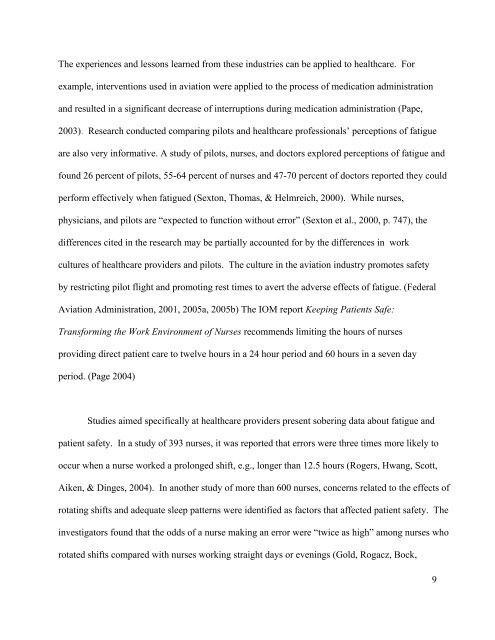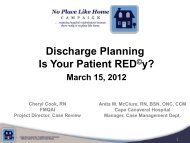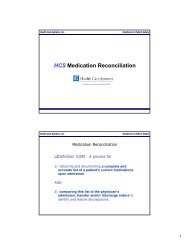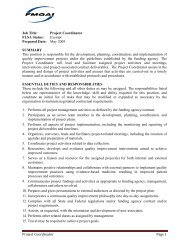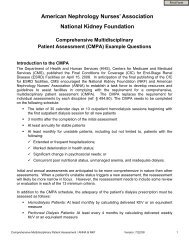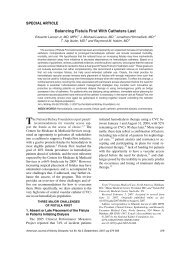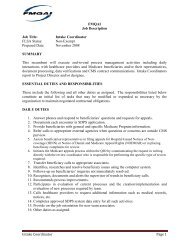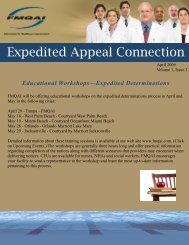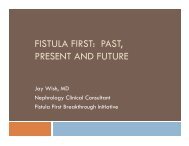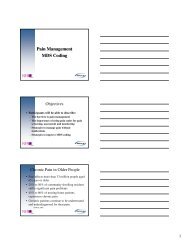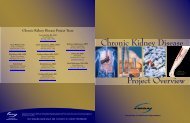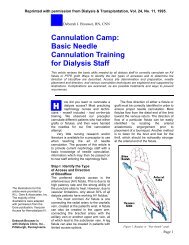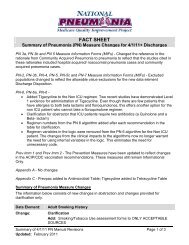The Nurse's Role in Promoting a Culture of Patient Safety - FMQAI
The Nurse's Role in Promoting a Culture of Patient Safety - FMQAI
The Nurse's Role in Promoting a Culture of Patient Safety - FMQAI
Create successful ePaper yourself
Turn your PDF publications into a flip-book with our unique Google optimized e-Paper software.
<strong>The</strong> experiences and lessons learned from these <strong>in</strong>dustries can be applied to healthcare. For<br />
example, <strong>in</strong>terventions used <strong>in</strong> aviation were applied to the process <strong>of</strong> medication adm<strong>in</strong>istration<br />
and resulted <strong>in</strong> a significant decrease <strong>of</strong> <strong>in</strong>terruptions dur<strong>in</strong>g medication adm<strong>in</strong>istration (Pape,<br />
2003). Research conducted compar<strong>in</strong>g pilots and healthcare pr<strong>of</strong>essionals’ perceptions <strong>of</strong> fatigue<br />
are also very <strong>in</strong>formative. A study <strong>of</strong> pilots, nurses, and doctors explored perceptions <strong>of</strong> fatigue and<br />
found 26 percent <strong>of</strong> pilots, 55-64 percent <strong>of</strong> nurses and 47-70 percent <strong>of</strong> doctors reported they could<br />
perform effectively when fatigued (Sexton, Thomas, & Helmreich, 2000). While nurses,<br />
physicians, and pilots are “expected to function without error” (Sexton et al., 2000, p. 747), the<br />
differences cited <strong>in</strong> the research may be partially accounted for by the differences <strong>in</strong> work<br />
cultures <strong>of</strong> healthcare providers and pilots. <strong>The</strong> culture <strong>in</strong> the aviation <strong>in</strong>dustry promotes safety<br />
by restrict<strong>in</strong>g pilot flight and promot<strong>in</strong>g rest times to avert the adverse effects <strong>of</strong> fatigue. (Federal<br />
Aviation Adm<strong>in</strong>istration, 2001, 2005a, 2005b) <strong>The</strong> IOM report Keep<strong>in</strong>g <strong>Patient</strong>s Safe:<br />
Transform<strong>in</strong>g the Work Environment <strong>of</strong> Nurses recommends limit<strong>in</strong>g the hours <strong>of</strong> nurses<br />
provid<strong>in</strong>g direct patient care to twelve hours <strong>in</strong> a 24 hour period and 60 hours <strong>in</strong> a seven day<br />
period. (Page 2004)<br />
Studies aimed specifically at healthcare providers present sober<strong>in</strong>g data about fatigue and<br />
patient safety. In a study <strong>of</strong> 393 nurses, it was reported that errors were three times more likely to<br />
occur when a nurse worked a prolonged shift, e.g., longer than 12.5 hours (Rogers, Hwang, Scott,<br />
Aiken, & D<strong>in</strong>ges, 2004). In another study <strong>of</strong> more than 600 nurses, concerns related to the effects <strong>of</strong><br />
rotat<strong>in</strong>g shifts and adequate sleep patterns were identified as factors that affected patient safety. <strong>The</strong><br />
<strong>in</strong>vestigators found that the odds <strong>of</strong> a nurse mak<strong>in</strong>g an error were “twice as high” among nurses who<br />
rotated shifts compared with nurses work<strong>in</strong>g straight days or even<strong>in</strong>gs (Gold, Rogacz, Bock,<br />
9


